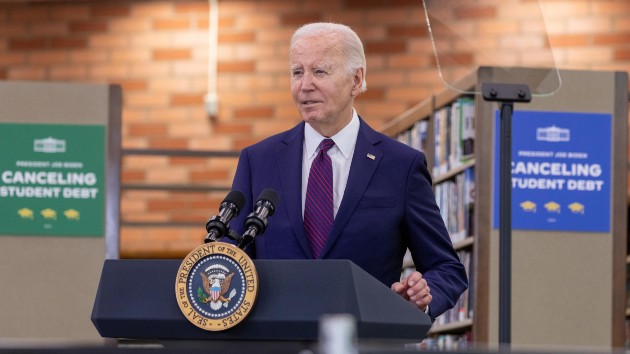(WASHINGTON) — President Joe Biden touted a new pathway for debt relief that kicked into gear Wednesday for 153,000 student loan borrowers, calling it a ticket to “chase dreams” in a speech in Culver City, California, and highlighting a key part of his 2024 campaign strategy.
“Folks, I’m happy to have been able to forgive these loans because when we realize and relieve Americans of their student debt, they’re free to chase their dreams,” Biden told a small group gathered at Julian Dixon Public Library.
The debt relief announced Wednesday is for those enrolled in a new student debt repayment plan rolled out this past fall, who took out a small initial balance and have been paying it down for a decade or longer.
“This action will be a huge help to graduates of community college and borrowers with smaller loans, putting them back on track faster for debt forgiveness than ever before,” Biden said.
The Department of Education has estimated that 85% of community college students would be debt free within 10 years if they enrolled in the new plan, called SAVE.
Roughly 7.5 million people are currently enrolled in SAVE so far, so the roughly 150,000 people who qualify equates to only 2% of all enrollees. Another four million people in the SAVE Plan have also had their monthly payments reduced to $0 a month because their incomes are below minimum wage.
The plan also shields borrowers from unpaid interest accrual, one of the largest additional fees that borrowers face on their loans, because unpaid interest is forgiven so long as qualified borrowers make their monthly payments on the loan itself — even if their required payment is $0.
Starting this summer, the plan will also cut down the amount that borrowers have to make on their monthly payments by half — from 10% of their discretionary income to 5%.
“This plan is the most generous repayment program ever and today we’re doing it even faster and quicker than ever before,” Biden said.
College debt is a major 2024 campaign issue for young voters, and many were left disappointed when Biden couldn’t follow through on his pledge to cancel $10,000 to $20,000 in debt last year after the U.S. Supreme Court overturned his sweeping debt relief policy.
Biden’s continued efforts to cancel debt in a more piecemeal fashion have now reached nearly 3.9 million borrowers, which he continues to highlight on the campaign trail in an attempt to gain support from a key voting group.
“This is the kind of relief that can be life changing for individuals and for their families. And it’s good for the economy as a whole. By freeing millions of Americans from the crushing debt of student loan programs it means they can finally get on with their lives instead of getting their lives being put on hold,” Biden said on Wednesday.
Some of the other approaches the Biden administration has taken on debt relief include fixing programs like Public Service Loan Forgiveness and income-driven repayment plans, or going after colleges that have defrauded students.
And the administration is continuing to work on a plan B to Biden’s initial debt relief proposal that was rejected by the Supreme Court, taking a narrower approach that could cancel debt for people most constrained by it.
The administration hopes this more bureaucratic approach will not be overturned by the court yet again — though borrowers should be cognizant that it is almost certain to face lawsuits once it reaches its final stages this summer.
The number of borrowers who may receive student loan debt forgiveness under the new policy proposal is vast: it could range from automatic cancellation for people who are on the edge of defaulting on their loans in the near future to application-based relief that could be used on more individualized cases, like people who are struggling to pay down their debts because of costs like health care or housing.
But it doesn’t stop there. Other factors include looking at the amount borrowers are paying toward their student loans compared to how much money borrowers have, including income and assets, as well as loans they have outside of higher education and whether they’ve been able to pay those down.
The department also wants to look at whether borrowers received a Pell Grant, designed for low-income college students, and whether they use any other government support programs.
Other aspects of the proposal, which are less sweeping but had been discussed in the past three monthly meetings held by the Department of Education, focus on borrowers who have more debt now than they initially took out, have loans that they first took out over 25 years ago, have large loans from schools that provided insufficient career advancement opportunities and who qualify for debt relief already under programs like Public Service Loan Forgiveness or income-driven repayment plans — but haven’t received it.
Copyright © 2024, ABC Audio. All rights reserved.












